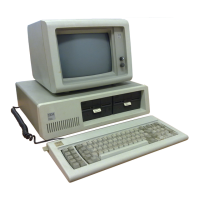14.31818-MHz crystal,
is
divided by 3 for the microprocessor
clock, and by 4
to
obtain the 3.58-MHz color burst signal
required for color televisions.
At
the 4.77-MHz clock rate, the 8088 bus cycles are four clocks
of
21O-ns, or 840-ns.
I/O
cycles take five 21O-ns clocks or
1.05-lts.
The system board contains circuits for attaching an audio
cassette, the keyboard, and the speaker. The cassette adapter
allows the attachment of any good quality audio cassette through
the earphone output and either the microphone or auxiliary
inputs. The system board has a jumper for either input. This
interface also provides a cassette motor control for transport
starting and stopping under program control. This interface reads
and writes the audio cassette
at
a data rate
of
between 1,000 and
2,000 baud. The baud rate
is
variable and depend
on
data
content, because a different bit-cell time is used for
O's
and
l's.
For
diagnostic purposes, the tape interface can loop read to write
for testing the system board's circuits. The ROM cassette
software blocks cassette data and generates a cyclic redundancy
check (CRC) to check this data.
The system board contains the adapter circuits for attaching the
serial interface from the keyboard. These circuits generate an
interrupt to the microprocessor when a complete scan code
is
received. The interface can request execution
of
a diagnostic test
in the keyboard.
Both the keyboard and cassette interfaces
on
the system board
are 5-pin DIN connectors that extends through the rear panel of
the system unit.
1-4
System Board

